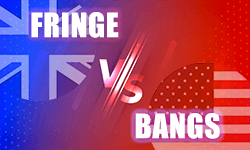
Language is a living entity, constantly evolving and adapting. One fascinating aspect of English is the variation in vocabulary between British English vs. American English. This linguistic divergence can be seen in simple words familiar to speakers on both sides of the Atlantic, yet they use different terms for the same concept. A classic example is the term for hair that falls over the forehead: “fringe” and “bangs,” which we’ll cover in this article by employing examples and their etymology.
Inhaltsverzeichnis
“Fringe” or “Bangs”
“Bangs” and “fringe” are two sides of the same coin; both nouns refer to strands of hair that fall over the forehead. They can vary in length and shape, from curtain bangs to blunt-cut fringes, highlighting the linguistic difference between American and British English.
“Bangs” is more commonly used in countries that use American English, such as Canada. “Fringe,” on the other hand, is preferred in British English and Australian English, for example. Essentially, both terms can be considered synonyms, though the choice depends on the dialect you use.

British English
fringe

American English
bangs
While both spellings are correct, the choice depends on the employed English variant. To guarantee coherence, it is recommended to use the spelling that aligns with your chosen variant.
Examples of using “fringe” and “bangs” as nouns
The following examples will demonstrate the linguistic divergence of the nouns “fringe/bangs” in British and American English.
- British English: Fringe
- American English: Bangs


Etymology and origin
The existence of both terms is a result of the natural evolution of language and regional variations. English has many examples of words that have developed differently in British and American English due to cultural influences, migration, and the natural divergence of the English language over time. “Bangs” and “fringe” both refer to the same hairstyle, but have different cultural and historical contexts. Below, we’ll explain each word’s origin and etymology.

The British English term “fringe” has a longer history, originating from the Old French “frenge,” which is derived from the Late Latin “fimbria,” which translates to “fiber” or “thread.” The word later evolved to describe decorative borders or edges made of threads, cords, or other materials in the 1640s.
The transition to “fringe” describing hair most likely stems from the visual similarity between decorative fringes on clothing and the hair that falls over the forehead, resembling a decorative edge. Similar to the meaning of borders and edges, sayings such as “to be on the fringe” were created in both British and American English to describe being on the outer edge of a group or society, implying being unconventional or extreme.

The American English term “bangs” is believed to have originated in the 19th century from the practice of cutting hair straight across the forehead, similar to how a horse’s tail was cut horizontally for a tidy appearance, known as “bang-tail.” There are documented references to men and women wearing bangs in Ancient Egypt, Ancient Greece, and the Roman Empire.
In different historical periods, women who wore bangs faced criticism as they were sometimes viewed as rebellious or unconventional, challenging traditional norms of femininity in the late 19th to early 20th centuries.
Both terms can mostly be used interchangeably due to a bangs/fringe revival. Particularly during the COVID-19 pandemic, self-styled curtain bangs became popular again through social media apps such as TikTok. However, for an academic essay or a thesis, it is important to maintain coherence and consistency.
FAQs
Both terms mean the same thing, yet “fringe” is mostly used in countries that use British English, while “bangs” is preferred in countries using American English.
The use of “bangs” in American English and “fringe” in British English highlights the linguistic evolution influenced by historical practices, cultural preferences, and popular culture in each region.
Besides “fringe” meaning a part of the hair that covers one’s forehead, it also refers to an outer border of an area or group. The idiom “to be on the fringe” means to be on the outer edges of a group, activity, or society. It often implies being outside the mainstream or central part, sometimes with the connotation of being unconventional or unimportant. This saying can be used in social, political, or cultural contexts.
The terms can be used interchangeably; however, it is important to note that people in the United States might not know the term “fringe.” If you use fringe/bangs in academic writing, it is important to maintain consistency and either use British English or American English terminology.
numerous advantages for Canadian students:
- ✓ 3D live preview of your configuration
- ✓ Free express delivery for every order
- ✓ High-quality bindings with individual embossing

